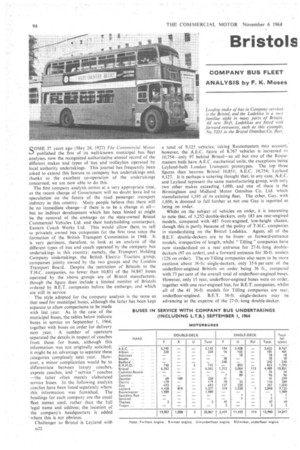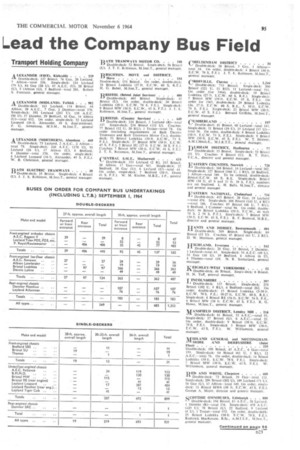Bristol's Lead the Company Bus Field
Page 96

Page 97

If you've noticed an error in this article please click here to report it so we can fix it.
SOME 37 years ago (May 24, 1927) The Commercial Motor published the first of its well-known municipal bus fleet analyses, now the recognized authoritative annual record of the different makes and types of bus and trolleybus operated by local authority undertakings. This journal has frequently been asked to extend this feature to company bus undertakings and, thanks to the excellent co-operation of the undertakings concerned, we are now able to do this.
The first company analysis comes at a very appropriate time, as the recent change of Government will no doubt have led to speculation on the future of the road passenger transport industry in this country. Many people believe that there will be no immediate change-if there is to be a change at allbut no indirect development which has been hinted at might he the removal of the embargo on the state-owned Bristol Commercial Vehicles Ltd. and their bodybuilding counterpart, Eastern Coach Works Ltd. This would allow them to sell to privately, owned bus companies for the first time since the formation of the British Transport Commission in 1948. It is very pertinent, therefore, to look at an analysis of the different types of bus and coach operated by the company bus undertakings in this country; namely, the Transport Holding Company undertakings, the British Electric Traction group, companies jointly owned by the two groups and the London Transport Board. Despite the restriction of Bristols to the T.H.C. companies, no fewer than 10,851 of the 34,847 buses operated by the above groups are of Bristol manufacture, though •the figure does include a limited number of Bristols ordered by B.E.T. companies before the embargo, and which are still in service.
buses in service on September 1, 1964, together with buses on order for delivery next year. A number of operators separated the details in respect of coaches from those for buses, although this information was not originally solicited; it might be an advantage to separate these categories completely next year. However, a minor complication would be to differentiate between luxury coaches, express coaches, and " service" coaches -the latter often merely elaborated service buses. In the following analysis coaches have been listed separately where this information was furnished. The headings for each company are the usual fleet names used. rather than the full legal name and address; the location of the company's headquarters is added where this is not obvious.
Challenger to Bristol is Leyland with D12
a total of 9,125 vehicles; taking Routemasters into account, however, the A.E.C. figure of 8,767 vehicles is increased to 10,754-only 97 behind Bristol-as all but two of the Routemasters built have A.E.C. mechanical units, the exceptions being Leyland-built London Transport prototypes. The top three figures then become Bristol 10,851; A.E.C. 10,754; Leyland 9,127. It is perhaps a sobering thought that, in any case, A.E.C. and Leyland represent the same manufacturing group, with only two other makes exceeding 1,000, and one of these is the Birmingham and Midland Motor Omnibus Co. Ltd. which manufactured 1,595 of its existing fleet. The other, Guy, with 1.050, is doomed to fall further as not one Guy is reported as being on order.
Whilst on the subject of vehicles on order, it is interesting to note that, of 1,252 double-deckers, only 183 are rear-engined models, compared with 487 front-engined, low-height chassis. though this is partly because of the policy of T.H.C. companies in standardizing on the Bristol Lodekka. Again, all of the B.E.T. double-deckers are to be frontor forward-entrance models, irrespective of length, whilst " Tilling " companies have now standardized on a rear entrance for 27-ft.-long doubledeckers (97 on order), and a forward entrance for 30-ft. models (226 on order). The ex-Tilling companies also seem to be more cautious about 36-ft: single-deckers, only 35-6 per cent of the underfloor-engined Bristols on order being 36 ft., compared with 77 per cent of the overall total of underfloor-engined buses. However, only 15 rear, underfloor-engined buses were on order, together with one rear-engined bus, for B.E.T. companies, whilst all of the 41 36-ft. models for Tilling companies are rear, underfloor-engined. B.E.T. 36-ft. single-deckers may be advancing at the expense of the 27-ft.-long double-decker.












































































































































































